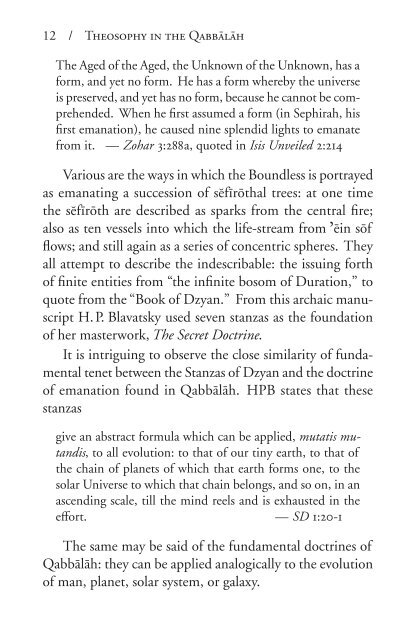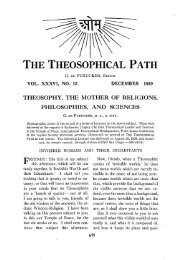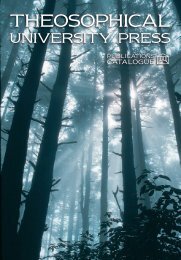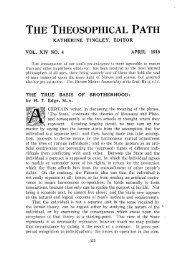Theosophy in the Qabbālāh - The Theosophical Society
Theosophy in the Qabbālāh - The Theosophical Society
Theosophy in the Qabbālāh - The Theosophical Society
Create successful ePaper yourself
Turn your PDF publications into a flip-book with our unique Google optimized e-Paper software.
12 / <strong><strong>The</strong>osophy</strong> <strong>in</strong> <strong>the</strong> Qabbãlãh<br />
<strong>The</strong> Aged of <strong>the</strong> Aged, <strong>the</strong> Unknown of <strong>the</strong> Unknown, has a<br />
form, and yet no form. He has a form whereby <strong>the</strong> universe<br />
is preserved, and yet has no form, because he cannot be comprehended.<br />
When he first assumed a form (<strong>in</strong> Sephirah, his<br />
first emanation), he caused n<strong>in</strong>e splendid lights to emanate<br />
from it. — Zohar 3:288 a, quoted <strong>in</strong> Isis Unveiled 2:214<br />
Various are <strong>the</strong> ways <strong>in</strong> which <strong>the</strong> Boundless is portrayed<br />
as emanat<strong>in</strong>g a succession of sêfîrõthal trees: at one time<br />
<strong>the</strong> sêfîrõth are described as sparks from <strong>the</strong> central fire;<br />
also as ten vessels <strong>in</strong>to which <strong>the</strong> life-stream from ¿ÿ<strong>in</strong> sõf<br />
flows; and still aga<strong>in</strong> as a series of concentric spheres. <strong>The</strong>y<br />
all attempt to describe <strong>the</strong> <strong>in</strong>describable: <strong>the</strong> issu<strong>in</strong>g forth<br />
of f<strong>in</strong>ite entities from “<strong>the</strong> <strong>in</strong>f<strong>in</strong>ite bosom of Duration,” to<br />
quote from <strong>the</strong> “Book of Dzyan.” From this archaic manuscript<br />
H. P. Blavatsky used seven stanzas as <strong>the</strong> foundation<br />
of her masterwork, <strong>The</strong> Secret Doctr<strong>in</strong>e.<br />
It is <strong>in</strong>trigu<strong>in</strong>g to ob serve <strong>the</strong> close similarity of fundamental<br />
tenet between <strong>the</strong> Stanzas of Dzyan and <strong>the</strong> doctr<strong>in</strong>e<br />
of emanation found <strong>in</strong> Qab bãlãh. HPB states that <strong>the</strong>se<br />
stanzas<br />
give an abstract formula which can be applied, mutatis mu-<br />
tandis, to all evolution: to that of our t<strong>in</strong>y earth, to that of<br />
<strong>the</strong> cha<strong>in</strong> of planets of which that earth forms one, to <strong>the</strong><br />
solar Universe to which that cha<strong>in</strong> belongs, and so on, <strong>in</strong> an<br />
ascend<strong>in</strong>g scale, till <strong>the</strong> m<strong>in</strong>d reels and is exhausted <strong>in</strong> <strong>the</strong><br />
effort. — SD 1:20 -1<br />
<strong>The</strong> same may be said of <strong>the</strong> fundamental doctr<strong>in</strong>es of<br />
Qabbãlãh: <strong>the</strong>y can be applied analogically to <strong>the</strong> evolution<br />
of man, planet, solar system, or galaxy.













